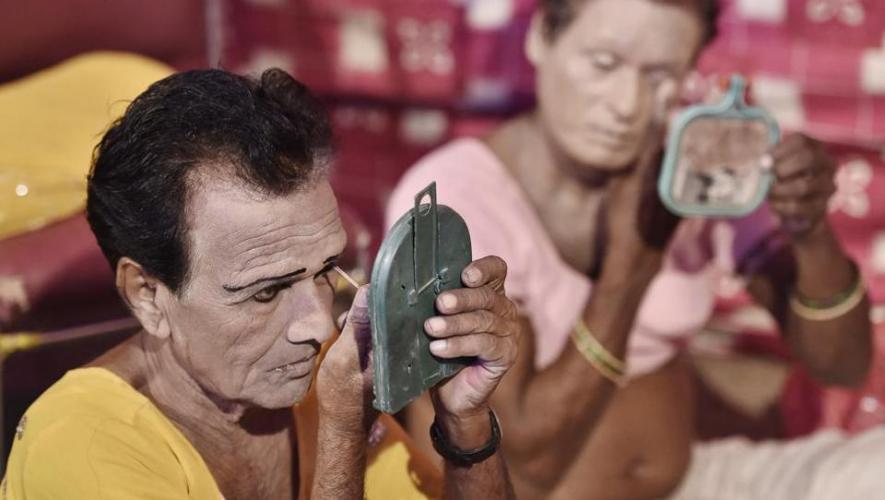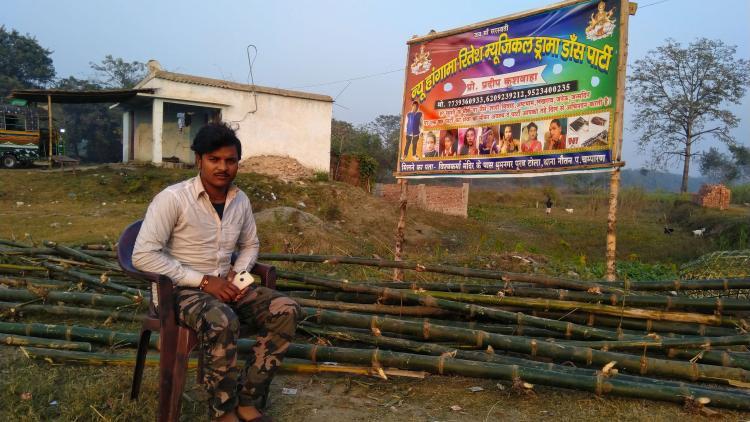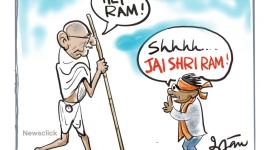Launda Naach: Keeping Folk Art Alive in Bihar

Image for representational use only.Image Courtesy : HT
“My family never wanted me to get into this field, so I resisted. My resistance furthered my father’s anger. I was beaten up by my father; my hand was also fractured,” says Rajeev Kumar (name changed on request). Rajeev is a member of the newly-formed ‘New Hangama Ritesh Musical Drama Dance Party’, a Launda Naach ensemble in West Champaran, Bihar.
Launda Naach is an archaic agrarian theatre form of Bihar; literally, Launda translates to ‘bachelor’ and Naach means ‘dance’. It has not only invited a general tone of appreciation for its unique impersonation technique, where men emulate femininity, but also indignation among personal circles of impressionists who perform this art.

âGoddess has endowed humans with different skills,â says Pradeep, pointing to paintings of the Hindu goddess Saraswati printed on the top corners of the banner. âIt is on us to identity and hone that skill for a livelihood.â
Rajeev, too, faced opposition and had to run away from his home. The only child of his parents, Rajeev is now earning around only Rs 70k per annum, while his father—a government employee—earned Rs 40k in one month.
Yet, there are thousands of people in Bihar like Rajeev, for whom Launda Naach is a passion and a lifeline, “Everyone enjoys Launda Naach, then why this sense of untouchability? This is hypocrisy,” says Pradeep Kushwaha, the founder of ensemble, “a Launda Naach artiste is also the member of this society, he is not an alien.” With time, this chasm has decreased, however, cases like that of Rajeev are fresh reminders that social acceptance is still further away. Pradeep adds, “What happened to Rajeev was unfortunate; social rigidity will take some time to vanish.”
Pradeep, who is in his twenties, did not have any support to fulfil his dream of establishing his own ensemble. Besides, it required funds. “We are a big family of four brothers. That is another story of a peasant’s family, there is nothing interesting or new about it,” he says. “I could not continue studies after primary school. It was time to move outside of state to earn and eat,” Pradeep, who belongs to the other backward class (OBC) community of Koeris said while recounting how financial restrictions pushed him to manual labour. He travelled far, to Tamil Nadu, the southernmost state of India.
After gathering enough money with some five years of labour, he decided to return home as he wanted to do something on his own, he says. The folk art form of Launda Naach grabbed his attention. His uncle, an artiste, inspired him to join this. Even though he was aware of the performing art, he did not know its business model. For three years, he worked with several ensembles and curried favour with their artistes. He, then, founded a 20-member group in August this year; the members are his artiste friends from ensembles he had worked with previously.. Many of them are tribal boys, from distantly located Tharuhat regions of Bihar and Nepal, which largely remain cut off from mainland Bihar. Meanwhile, Pradeep has also got a new found talent, that of a singer.
Launda Naach has been well received by the audience of various faiths, beliefs and cultures in eastern India and southern Nepal. Additionally, it also aims to revive the folk songs and music. Along with the Bulbul tarang or Indian banjo, which is a characteristic feature of Launda Naach, Pradeep’s ensemble also has western instruments like percussion pad and jazz drum set. And the ensemble must produce engaging content, utilising new instruments and new age cinema, to keep going.
The founder of the ensemble says that their journey was not a smooth one, as the presence of ‘Aarkestra’ [indigenised term for ‘Orchestra’ in Bihar] consistently served caveats. In Bihar, the use of term Aarkestra is slightly different, much against its conventional use in western cultures. Aarkestra is mostly synonymous with lewd dance troupes who objectify female dancers to appease the audience comprising mostly of rural and semi-urban youths. In fact, this has now evolved as a medium of human trafficking, with reports suggesting that the victims are girls from poor families of Bengal, Assam and Nepal.
On the other hand, Launda Naach does not have a female member. The primary reason behind this is again the social restrictions placed upon women, who have been evidently shunned by such professional groups and their presence in the field of performing arts is almost negligible because of ‘entrenched prejudice against women’. This also explains the presence of trafficked women in Aarkestra groups.
“Aarkestra certainly gained popularity in the past decades but it is now seeing a major decline,” says Pradeep, explaining further that, “Aarkestra is not versatile. Launda Naach is not just about dance; it also has humour, drama, singing and satire. A normal Launda Naach programme has an average run-length of 5-hours. Sometimes artistes regale the audience with an impactful play-based on nuances of daily life, and other times they fill the air with wisecracks.”
However, there have been times when sexist songs and stereotyping acts are being performed during Launda Naach programmes. Their major dilemma, as explained by Pradeep, is that they are forced to perform such acts to fulfil the audience’s demands, otherwise the youths, who have entered this field, would be jobless.
“I needed a total seed capital of Rs. 19 lakh,” he says, “I had some savings and the remaining amount was taken from moneylenders. Let’s see how much I can recover. The fate of our group depends on it.” The seed money includes payments made to artistes, charge for two restrooms, clothes, music system and the like.
Group artistes in this field are paid on a seasonal basis. Here, the pay range is between Rs. 60,000 to Rs. 1,25,000 per head, depending on individual talent and pay scale. The seasonal pay is for one year, but in reality that roughly covers just nine months. Payment is made in three equal instalments and the manager is solely responsible for the loss as a result of unavailability of programmes. Luckily, Pradeep has done some 40 programmes—in Sitamarhi, Righa [Nepal], Muazaffarpur, Bettiah, Majhaulia, Areraj, Bagaha, etc.—since the formation of the group and has been able to recover around Rs. 6 lakh. He, therefore, is feeling hopeful about the future.
The ensemble has no ‘saata’ (engagement) for now, due to the inauspicious Hindu month of Malmas or Kharmas. As possibilities of gaining saata are rare, most of the artistes have gone home, far away from the office located near Kathaiya chowk on Bettiah-Areraj road.
This reporter contacted a few of the artistes to find out more about their livelihood. Pramod Nat, 40, and Jahangir Nat, 25 both belong to the scheduled caste category. They live close to Pradeep’s ancestral home in Mahana Chowk area of Chanpatia block. Elder brother Pramod, is also known as Pramod ‘singer’. He says, “What else did I have? Voice!”
“I dance,” says Jahangir, “I followed my brother. I liked it and stayed.”
A resident of Chhapwa of East Champaran, Nandlal Ram, is a dalit. Given the feudal nature of the local society, he, like the Nat brothers, also had limited options. Nandlal, in his forties, is the brain behind the performances of this ensemble; Pradeep calls him ‘director’. When asked about his backstory, he says, “Everyone does something to earn a living. I do this. The government does not support us.”
To the surprise of this reporter, most members of the ensemble, all of whom are school dropouts, turned out to be tech savvy. They have successfully created a personal YouTube profile where they collect amateur videos of their performances, they also use digital devices to download various media contents to produce acts.
Despite its omnipresence, which also comes as a major source of employment in poverty afflicted Bihar [for instance, there are an estimated ten Launda Naach ensembles within a diameter of 20 kilometres], Launda Naach is seen as a subject of ridicule inside and outside of the state.
Bhikhari Thakur, the doyen of Bhojpuri literature, was remembered by Badri Narayan in “Culture and Emotional Economy of Migration”:
Bhikhari Thakur was the first to cast young, talented boys of the Bhojpuri region in female roles and popularise launda dance. In this manner he also incorporated characters like launda and labaar in the bidesha folk theatre.
The only Launda Naach artiste to be recognised by the government is Ram Chandra Manjhi, the only living member of Bhikhari Thakur’s theatre, who was awarded Sangeet Natak Academi Award at the age of 93.
However, Pradip’s ensemble does not know that an artiste, who started like them in a poor and socially ostracised family, has been awarded the highest national recognition in the field of performing arts.
Even though Bihar’s politicians, given a chance to speak or write about Bhikhari Thakur, immortalise him in the stylish prose, but they have failed to recognise what Thakur stood for– ‘Launda Naach as an art form’. Anyway, Bhikhari Thakur summarises the socio-political reality of Bihar in a line in his famous play ‘Bideshiya’: “Bideshiya ke naach na hawan, Bideshiya ke tamasha hawan ([…]it is not a dance but rather a tamasha).”
Get the latest reports & analysis with people's perspective on Protests, movements & deep analytical videos, discussions of the current affairs in your Telegram app. Subscribe to NewsClick's Telegram channel & get Real-Time updates on stories, as they get published on our website.























